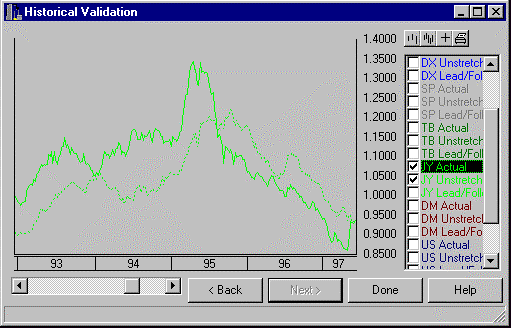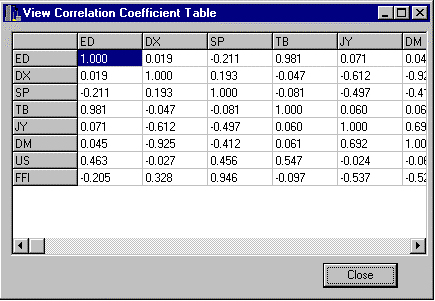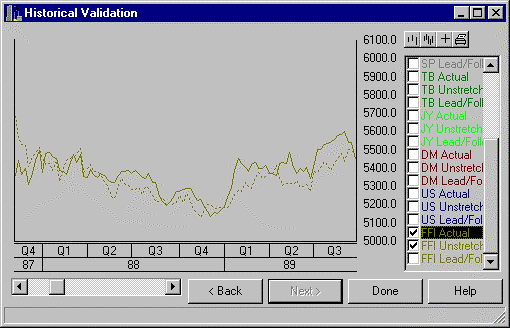| Monthly
Article
Topics for July |
||
|
This Issue
Various Topics
Tech Talk
Market Statistics
Notice:
Copyright (c) 1998 Commodity Systems Inc. (CSI). All rights are reserved.
|
Topics discussed in this month's journal.
We recently
promised Unfair Advantage® users a new set of multimarket analytical studies,
and we delivered on that promise in early June. The MultiMarket Analyzer (MMA)
is now helping Unfair Advantage users around the world to identify and
capitalize on the underlying forces affecting the markets today. The new
studies were added to UA just after we printed our latest manual, so an
on-screen help key was included to give full details and instructions. That
complete document, written by Steven Davis, explains how and why MMA works.
This newsletter partially summarizes and partially elaborates on the published
MMA materials, focusing primarily on the theories behind the studies.
This chart shows one of MMA's studies (the Davis Unstretched Indicator) and a detrended Perpetual Contract® price series for Japanese Yen. Additional screens yield more insights for traders. The chart shown here represents just one portion of a multi-screen analysis
performed by MMA. Additional indicators are used for determining market
relationships, contract selection and trade confirmation. Each of the following
steps is essential in understanding the process and maximizing returns.
Market and Data Series
Selection:
The indicators work best with many related markets (including stocks) and should never be run with less than three. A half-dozen markets would result in 15 different charts of paired spread opportunities. An example of appropriately related markets includes: corn, wheat, oats, soybeans and crude oil. The agricultural commodities are listed here because they share a common growing season and similar resources. Crude oil is included because farming is heavily reliant on the availability of affordable petroleum products for fuel. The recommended input series for all commodities is their detrended representations in weekly form captured from Perpetual Contract® data. We recommend detrended data because such a series makes it possible to give equal weight to all periods of history. By default, a detrended commodity series uses the very first day and the last day of the second-nearest future to linearly detrend. The very first day and the second-to-last day on file are used to linearly detrend stocks or commodity cash series. Perpetual Contract data is recommended for commodities because statistical stationarity is more likely to be present in the time series information, but back-adjusted data can alternately be used. MMA is capable of modeling daily, weekly (preferred) and monthly data. Specific guidelines are explained on the help screens. The user is advised that any stock, commodity or group of markets may be selected, and other time series, such as a market's seasonal index, may be used. Advanced software options let the user incorporate a lag between related markets to allow for various real-world economic factors such as the matching of nearby corn prices with future hog prices under the requirement that today's corn must represent hogs in a further distant period. On to Analysis:
In this example, (taken from the MMA help screen) Eurodollar and Treasury Bills have a high correlation coefficient of 0.981; Dollar Index and Deutschemark also have a high correlation coefficient, albiet negative of -0.925 and US Treasury Bonds and the Dollar Index have a minimal coefficient of -0.027. Other available screens include a graphic of "Correlation as a Function of Lag," a "Historical Validation" chart and numeric displays showing "Factor Analysis" and the "Current Intermarket Situation." An output comma separated values (CSV) ASCII file is also produced, allowing the
user to view and manipulate all fields simultaneously with third-party
software.
The strength of the correlation table should help the user choose the more promising related markets to be employed in the statistical work to follow. Should a spread opportunity develop, the correlation table would be an invaluable aid in confirming the wisdom of the given trade. The help screen points out that a perfect correlation value of +1 or -1 is generally considered an arbitrage situation, but that this simple rule can be misleading when doing a large-scale analysis such as this. Readers are warned that the common effects of a third, unstated factor can easily convince the user of seemingly logical falsehoods. A help-screen example: If corn were to rise, soybeans should rise too; live cattle should rise; consumption of cattle should fall; production of cattle should fall; and finally, the price of corn should fall. Even if each step in a five-step argument held 80% of the time, the a priori conclusion should only hold true (.805=.328) about 30% of the time because we are depending upon five equally probable serial events. To cope with this statistical limitation, eigenvalue analysis is applied. Eigenvalues and eigenvectors are often used to obtain the n-step transition probabilities of a Markov chain. Through this technique, one can produce independent indexes for each of the markets in the correlation coefficient table. The help screen points out that these indices, which, as a whole, completely capture the correlation information inherent in the data, are ranked according to how much variance each has had over time. A couple of the indices usually explain most of the variance. The remaining low variance indices explain little of the variance, but are very powerful predictive tools. As explained
on the help screen, the variance of each index is measured two equivalent ways:
1) by the percent of the variance contained, and 2) by the number of markets
which can be replaced, without loss, by including the factor. The low-variance
indices (at the bottom of the list) may well be arbitrage opportunities in that
they represent low-volatility spreads. The user is cautioned that while these
relationships may appear to be consistent, they could break at any time (as did
the Brazilian Real-U.S. Dollar peg). The MultiMarket Analyzer does not attempt
to tell you what will happen in the future. However, it does clearly
demonstrate what has happened in the past. The next step in MMA analysis will
help you determine which factors represent real market spread trading
opportunities.
"Stretching" Data in
Search of Misalignment
The basic
purpose of the Davis Stretch Index is to alert the user of possible market
opportunities within and between selected markets. High values of the index
suggest that the markets are misaligned and that there may be a buying, selling
or spread trading opportunity within the subset of markets presented. If you
observe high index levels for a given market or pair of markets, you should
explore the market(s) under investigation with the remaining MMA studies.
Picking Your Markets by
"Unstretching" Market Data:
The
MultiMarket Analyzer lets you select which indicators to view. The commodity or
stock price (FTSE Index in this example) appears as a solid line and the Davis
Unstretched Indicator as a dotted line.
The difference between this indicator and the parent price shows where and how far each given market's price is likely to go, assuming all of the other prices remain at their current levels, and given the insight taken from the remaining MMA study. If, for example you were analyzing corn, soybeans, and oats, and oats prices were significantly lower than expected (as suggested by the Davis Unstretched Indicator for oats), then there may be a buying opportunity for oats. Likewise, this indicator for corn would suggest where corn prices should be, given all the information on every market except corn. This study tries to accommodate the prices without regard to the specific economics of the various markets. It shows how far a given market would separately have to move to absorb as much of the underlying market forces as it can. The indicator for a given market may be several points away from that market's current price if the markets are insufficiently correlated to properly explain the movement of the indicator. Multiple statistical correlation analysis is generally an excellent tool for tracking market behavior. In a given correlation exercise, a set of N time series exists which typically represents markets that are correlated to a certain degree, as measured by the correlation coefficient between each pair. In each exercise there is typically one time series which represents the dependent variable (the series which we want to predict) and at least one time series which we would like to use as the sole basis for the prediction. The latter time series grouping is known as "the independent variable group." The Davis Unstretched Indicator identifies N dependent variables and N-1 independent variables. There happen to be [N*(N-1)]/2 pairs of combinations that one might consider as spread trades, where each combination permits one of the variables to be the dependent choice. An N of 4 markets, for example, would, according to the above equation, give rise to 4*3/2 or six combinations of markets to study. If the four candidate markets were identified as markets: 1,2,3, and 4, they would be represented by the combinations: 1,2; 1,3; 1,4; 2,3; 2,4; and 3,4. The user should examine each of the combinations to see which might provide the greatest opportunity for profit. This indicator, therefore, accomplishes its goal by giving every variable a turn at being predicted (the dependent time series) based solely upon the correlated movement of the balance of the "independent" markets. Any market prediction is made solely on the basis of the explained effects of all of the other independent markets. Theoretically, one could take multiple market positions in the "dotted line" dependent variable direction of each of the markets analyzed, but the commission "tax" might render resulting negative outcomes for the decidedly marginal profit opportunities. The spread trader might look for the pair of commodities with the biggest total discrepancy between the Davis Unstretched Indicator the corresponding current price level. Confirm a spread opportunity by consulting the correlation table to determine how closely the two market opportunities are correlated. If the correlation table shows a high reading of, say 0.90 or higher, then this may represent an excellent opportunity for speculative profit. In the real world, it is
unlikely that any one of these markets will make up all the price difference to
return the relationships to the norm. More commonly, each market moves a little
toward the center until equilibrium returns. MMA offers one final study,
explained next, to help the trader determine how this compromise will work out.
Classifying Followers and
Leaders:
This tool measures the recent historical tendency for the Davis Unstretched Indicator to lead or follow the market. Large positive values mean that in the recent past, a specific market has tended to lead broader market changes -- it has been leading the way. A large negative value means that a specific market has been slow to accommodate economic changes -- it has been trailing behind. A value near zero means that the market, in recent history, has held steady with the broader market - it is fully discounted and neither leads nor lags the selected markets. What we are attempting to convey with respect to this index is that markets which are clearly classified as leaders through high readings should be traded with significant caution in the suggested direction of the Davis Unstretched Indicator. Crude oil, a frequent market leader, experienced sustained rising market prices for a long period in the recent past, despite it being relatively overpriced. The long wait for crude oil to reverse direction finally came, but only after a significant delay. The help
screen advises that leading and fully discounted markets lend themselves to
trend-following market positions, but are not necessarily good candidates for
spread trades, which, in this situation, are likely to be risky and
unprofitable. A trailing market gives the trader the advantage of plenty of
time to get in, but the disadvantage of a potentially long wait for a profit
Getting the Big Picture:
The
Multi-Market Analyzer is well suited to CSI's Unfair Advantage product because
so many historical time series are made available for a small investment. You
can explore nearly unlimited market opportunities in world stock and commodity
markets with very little effort. We hope you will enjoy the challenge of this
new study and the worldwide scope of UA's database resources.
CSI MAKES NO REPRESENTATIONS OR GUARANTEES ABOUT THE CHANCES FOR PROFIT THROUGH THE USE OF THIS TOOL. THE TRADING OF COMMODITY FUTURES AND/OR STOCKS CAN BE FRAUGHT WITH GREAT FINANCIAL PERIL. CSI IS A DATA BANKING FIRM AND ALL STUDIES SUPPLIED ARE PROVIDED AT NO EXTRA CHARGE AND ARE NOT GUARANTEED TO PRODUCE RELIABLE AND PROFITABLE RESULTS. ALL TRADING DECISIONS SHOULD BE MADE WITH THE ADVICE AND SUPPORT OF QUALIFIED EXPERTS IN THE AREA OF TRADING AND INVESTMENT. Current Unfair Advantage subscribers may receive the upgraded version with these studies at no extra charge through our web site at http://www.csidata.com. MMA is not functional with trial
UA packages because it requires a minimum of 15 years of history on each market
introduced. The trial package includes a two-year historical database.
To find out about upgrading to
a full subscription, call our marketing staff at (800) 274-4727 or (561)
392-8663.
PAGE 1
|





